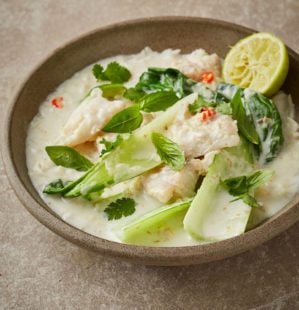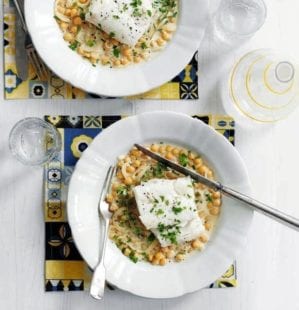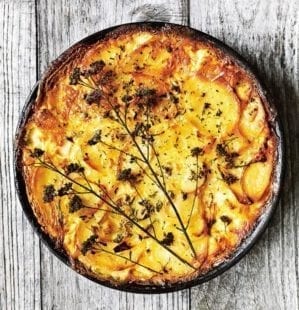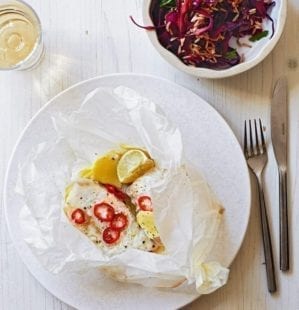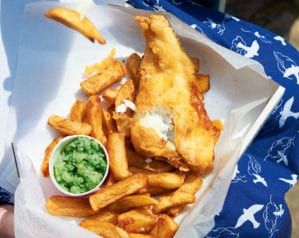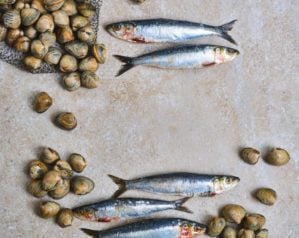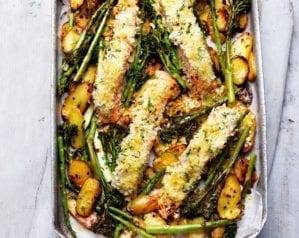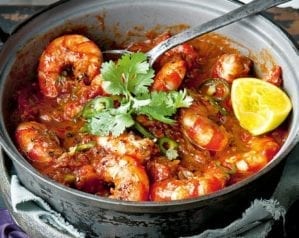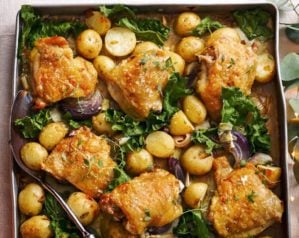
Almond-crusted pollock with tahini, potatoes and cavolo nero
- Published: 7 Feb 23
- Updated: 18 Mar 24
Alaska pollock is a firm white fish that, thanks to its sustainability credentials and lower price point, is a brilliant alternative to cod or haddock. Here, we’ve topped it with a nutty spiced crumb that protects the delicate flesh while baking and offers up bags of flavour.
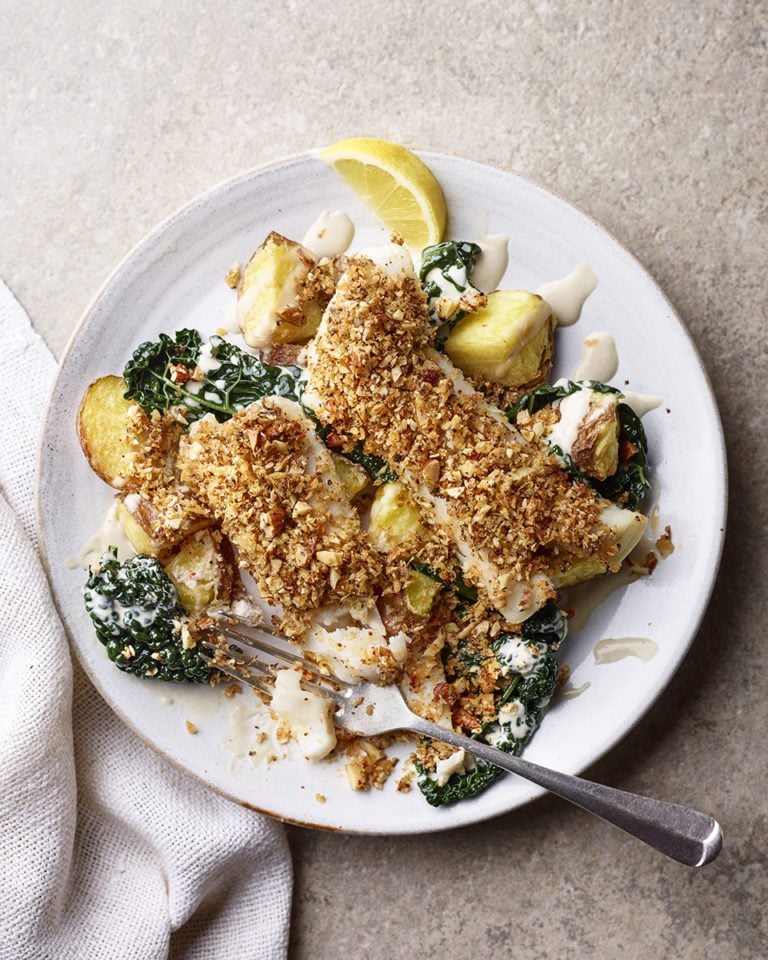
Check out Gill Meller’s luxurious pollock fish pie.
-
Serves 2
-
Hands-on time 15 min. Oven time 30 min
Ingredients
- 3 medium or 2 large potatoes
- Olive oil to fry and grease
- 2 large or 4 small (300g) skinless pollock fillets, defrosted if frozen
- 1 lemon, half juiced, half cut into wedges
- 1 small garlic clove, crushed
- 2 tbsp tahini
- 10g salted butter
- 120g cavolo nero, stalks removed, leaves torn
For the crust
- 1 tbsp za’atar
- 20g blanched almonds, finely chopped
- 20g coarse or panko breadcrumbs
- 1 tsp pul biber
- Finely grated zest 1 lemon
- 1 tsp olive oil
Method
- Heat the oven to 200°C fan/gas 7 and put a tray in to heat up. Cut the potatoes into chunks (about 4cm), pop them in a pan of cold salted water then cover and bring to the boil. Simmer for 5 minutes then drain and steam dry for 1 minute. Add 1 tbsp oil, season and ruffle them in the colander. Tip onto the hot baking tray and roast for 20 minutes.
- Meanwhile, season the pollock fillets with salt then sit them on a greased baking tray and drizzle with ½ tbsp oil. In a bowl, stir together all the crust ingredients then pack the mixture onto the fillets in an even layer.
- Once the potatoes have been cooking for 20 minutes, give them a stir then return to the oven. Bake the fish on the shelf above for 5-9 minutes, depending on the thickness of the fillets, until they are opaque and flake easily.
- In a bowl, stir together the lemon juice, garlic and tahini (it will sieze up and solidify, but this is fine). Trickle in 2-3 tbsp cold water until it loosens to a smooth, spoonable sauce. Season with a pinch of salt.
- In a frying pan, melt the butter then add the cavolo nero. Stir-fry for a minute or so until starting to wilt, then add a splash of water and cook until the water evaporates. Serve the potatoes and cavolo nero with the tahini sauce drizzled over then sit the fish on top, adding the lemon wedges to the side for squeezing.
- Recipe from January 2023 Issue
Nutrition
- Calories
- 771kcals
- Fat
- 35.9g (7g saturated)
- Protein
- 40.7g
- Carbohydrates
- 66g (4.3g sugars)
- Fibre
- 10.9g
- Salt
- 0.6g
delicious. tips
The Marine Conservation Society’s Good Fish Guide is a simple online tool that uses a traffic light rating system to help you make ocean-friendly seafood choices. Head to mcsuk.org/goodfishguide to find out more.
Before you start cooking, remove the fish from their packaging and sit on a plate lined with kitchen paper. Allowing the fillets to air-dry a little will help them take on seasoning and give a better texture once cooked.
Don’t waste it: Keep your cavolo nero stalks for stock or very finely chop them and add to a stir-fry.
Easy Swap: use kale or cabbage instead of cavolo nero if you prefer
“Alaska pollock is one of the biggest fisheries in the world, with around 3 million tonnes landed every year. Despite this staggering total, it’s a poster child for sustainable fishing with most of the Alaska pollock you can buy carrying the Marine Stewardship Council’s blue tick. While these fish are caught with huge nets, they don’t touch the seabed so there’s little collateral damage to the marine environment.
As you would guess from such huge and consistent catches, Alaska pollock finds its way into some well-known favourites, such as fish fingers. It’s a hugely efficient business too, with all the trimmings turned into surimi (crab sticks). Normally found in the freezer aisle, if you’re after a budget-friendly, mild flavoured, flaky white fish, it’s a brilliant option.”
– Jack Clarke, Sustainable Seafood Advocate at the Marine Conservation Society
Buy ingredients online
Rate & review
Rate
Reviews
Subscribe to our magazine
Food stories, skills and tested recipes, straight to your door... Enjoy 5 issues for just £5 with our special introductory offer.
Subscribe
Unleash your inner chef
Looking for inspiration? Receive the latest recipes with our newsletter

